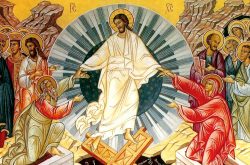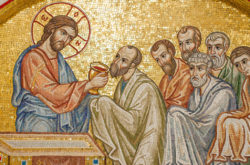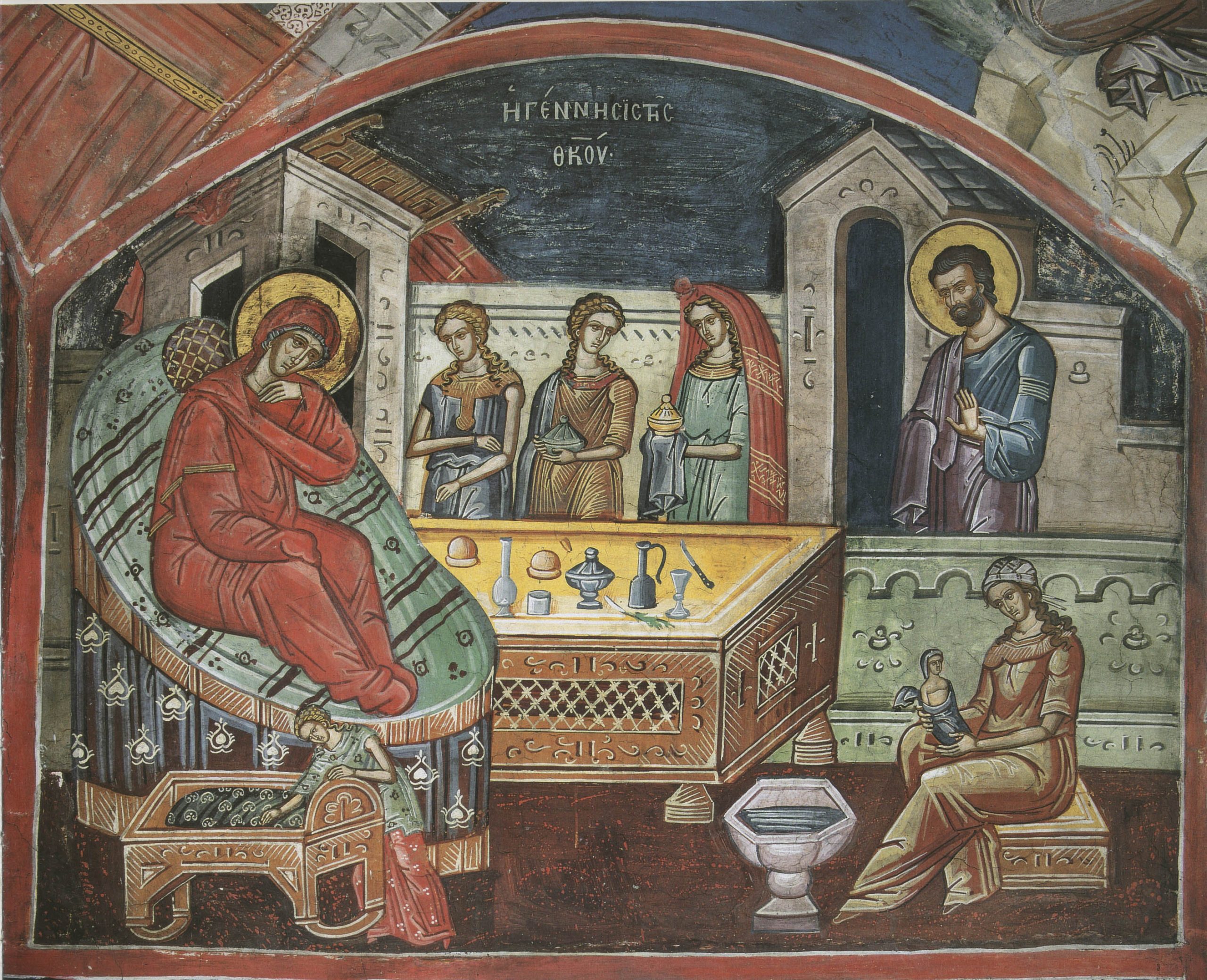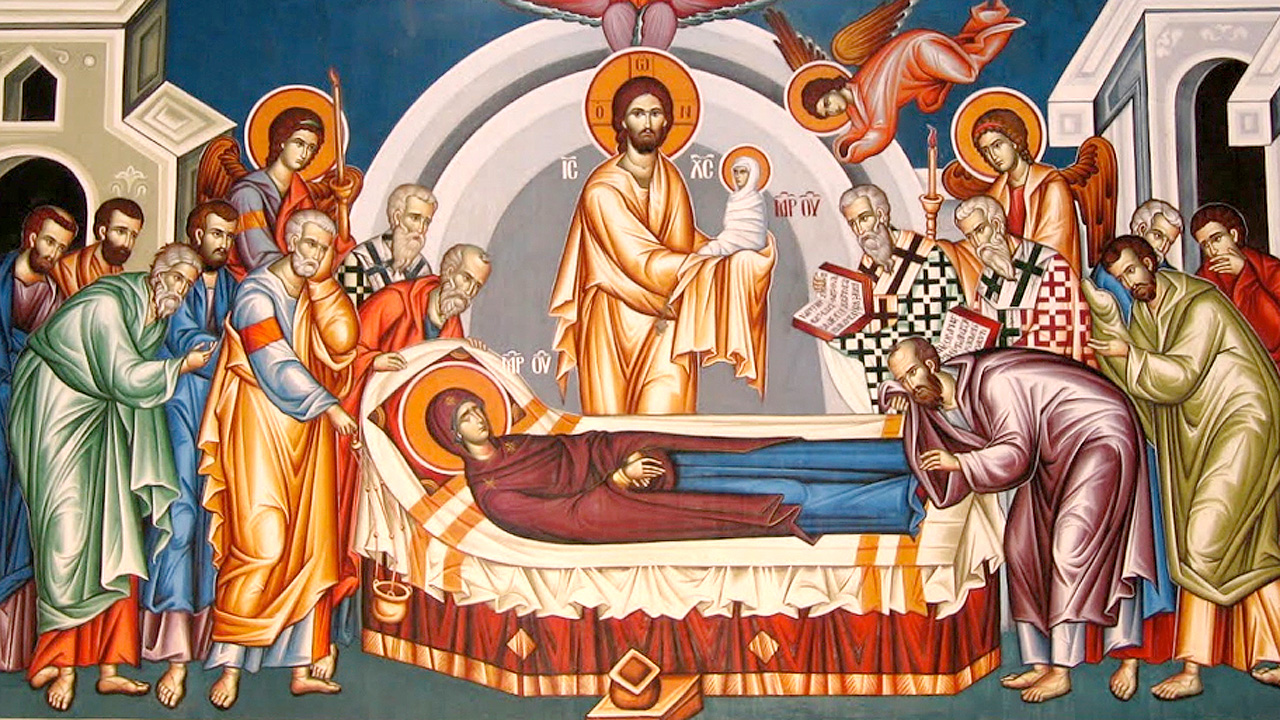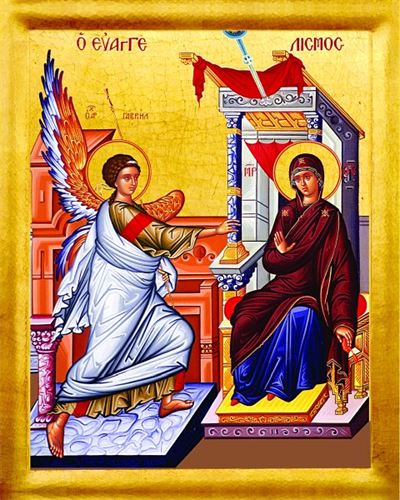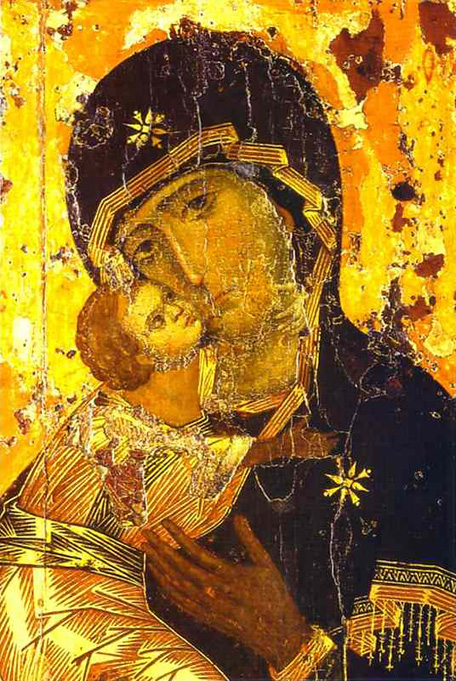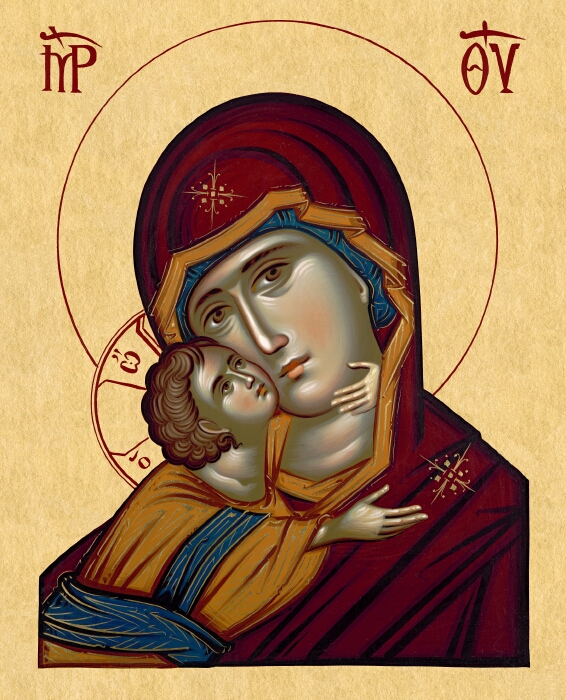“因為她被立為天,是神的殿” …. 而卡瓦西拉的聖尼古拉說,當上帝創造萬物,看到它們時,看到並說它們是 “一切美好”,這種 “一切美好”,這種美和善,是關於聖母的。這就是說,他們都是 “好事”,因為他們導致了聖母馬利亞,因為最後聖母馬利亞的出生。因此,馬利亞是所有創造的目的,也是《舊約》所有等待的終點。
那麼,她 “從母腹中 “成聖,正是因為她是她的父母約阿希姆和安妮大量禱告的結果,他們祈求上帝賜給他們一個孩子,並將她完全獻給上帝,她從嬰兒期就應許獻給上帝。
而我們聽到教會在聖母進殿的儀式上唱道:”聖殿是聖潔的,聖靈中的羔羊是聖潔的”。在那裡,聖母待了很多年,她被天使的食物所滋養,當她到了成熟的年齡,有了約瑟夫作為她的追求者,她接受了天使的擁抱,現在能夠對天使的信息說 “是”,說 “按照你的話祝福我”,接受上帝的意願在她身上得到實現。並從那時起,成為通過她的整個生命,化身為上帝的兒子和道的人。因此,她成為 “最寬廣的天堂”,天使的女王,以及真正值得讓地球成為天堂的人。
她的死亡最好的解釋是通過在這一天放置在我們教堂的神龕上的聖母像,作為整個慶祝活動的中心。
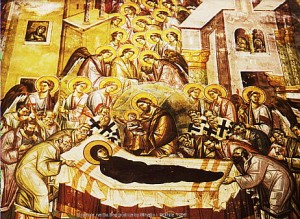
天主之母已經去世,正躺在她的病床上。基督的使徒們聚集在她的周圍,在高處的中心,是基督,他的手中握著他的母親,她活著並與他永遠結合在一起。
在這裡,我們一起看到了死亡和被聖母的具體死亡所克服的東西:不是分裂而是結合;不是悲傷而是快樂;最重要的是,不是死亡而是生命。”聖母馬利亞啊,你在出生時激發了童貞,在睡夢中你沒有安慰世界……”,教會在思索這幅聖像時唱道。
我想起了寫給聖母馬利亞的最深最美的讚美詩中的話。”萬歲,神秘的一天的黎明!” 。從聖母升天中湧出的光芒正是來自於這個無盡的、神秘的日子。
在思考這個死亡和看到這個死亡床時,我們明白不再有死亡,一個人的死亡事實已經成為一個生命的事件,一個生命統治的入口。
她把自己完全交給了基督,愛他到底,在死亡之門前與他相遇,然後死亡變成了一次快樂的相遇,生命取得了勝利,快樂和愛戰勝了一切。
幾個世紀以來,教會一直凝視著這位站在耶穌母親面前的人的死亡,並從中得到啓發,她給了我們的救主和救世主生命,她把自己完全交給了他,直到最後,獨自留在十字架下。通過研究她的聖母升天,教會發現並體驗到死亡不再是恐懼、恐怖和終結,而是光榮而真實的復活喜悅。”在你出生時,你的受孕是無暇的,在你睡覺時,你的死亡是豐富的……”
在這裡,在節日禮儀的第一首讚美詩中,我們看到這種喜悅的本質被表達出來:”壞死的人多了”。但這種文字對比的意義是什麼呢?在聖母升天儀式上,這個死亡的整個喜樂奧秘被揭示給我們,成為我們的喜樂,因為聖母馬利亞,就是我們中的一員。
如果死亡是分離的恐懼和悲傷,是陷入可怕的孤獨和黑暗,那麼這些東西在聖母馬利亞的死亡中都找不到,因為她的升天和她的整個生命一樣,是一種相遇、愛、走向和進入永恆的莧菜和聖所之光。
完美的愛 “驅除恐懼”,神學家約翰寫道,他所愛的使徒(約翰一書d.18)。 因此,在聖母馬利亞的豐富和不朽的升天中沒有恐懼。在這裡,死亡已經從內部崩潰,從所有讓它充滿恐怖和絕望的東西中解脫出來。死亡本身被轉化為生命的勝利。
死亡成為 “神秘的一天的黎明”。這就是為什麼這個節日沒有痛苦,沒有葬禮的悲嘆和悲傷,只有光明和喜悅。就好像我們走近自己不可避免的死亡之門,突然發現門大開,充滿了來自即將到來的勝利,來自即將到來的神的國度的曙光。
在這無可比擬的節日之光的照耀下,在這些黎明的日子里,當自然界達到其美麗的高度,成為讚美和希望的讚美詩,成為另一個世界到來的標誌時,聖母升天的讚美詩中的話語響起。”惡人的處女啊,自然的條件在你身上:因為有象徵性的離別,生命以死亡為紀念。象徵後的處女和死亡後的活人,女神啊,拯救你的遺產”(頌歌一)。
但是,為什麼聖母升天應該是值得的,而且是一個令人驚奇的原因?如果成了人的主耶穌嘗到了死亡之杯,拿撒勒的女兒,一個凡人的女人,怎麼可能不嘗呢?先知問道:”有任何一個人將活在世上而不死嗎?而使徒保羅向我們保證。”每個人都有一次死亡的機會”。
由於這些原因,聖母馬利亞也嘗到了痛苦的死亡。
按照學者的說法,沒有人活著無不嘗過死亡的滋味,而現在被讚美的馬利亞,作為一個人,也嘗過死亡的滋味。
但她死亡的細節我們並不清楚。在《聖經》中,他們會發現沒有提到馬利亞的死亡。如果她死了,也沒有死;如果她被埋葬了,也沒有。
“For she was made heaven and the temple of the Godhead” …. And St. Nicholas of Cavasila says that when God created all things and, seeing them, saw and said that they were “all good”, this “all good”, this beauty and goodness, was about the Virgin Mary. That is to say, they were all “good things” because they led to the Virgin Mary, because in the end the Virgin Mary would be born. Thus, Mary is the purpose of all creation and the end of all Old Testament waiting.
She, then, who was sanctified “from her mother’s womb” precisely because she was the fruit of much prayer on the part of her parents, Joachim and Annie, who asked God to grant them a child and to dedicate her entirely to God, was consecrated to God from infancy.
And we hear the Church sing in the service of the Presentation of the Presentation that “the holy of holies is holy, and the Lamb in the Holy Spirit is holy.” There the Virgin stays for years, there she is nourished with Angel’s food, and when she reaches a mature age and has Joseph as her suitor, she receives the archangelic embrace, and is now able to say “yes” to the Angel’s message, to say “bless me according to your word”, to accept that God’s will be done in her. And from then on, to become the one who, through her whole being, incarnates the Son and Word of God. And thus, she becomes the “broadest of the heavens”, the Queen of Angels, and the one who truly deserves to make the earth heaven.
Her death is best interpreted through the icon of the Dormition placed in the shrines of our churches on that day as the center of the whole celebration.
The Mother of God has died and is lying on her deathbed. Christ’s apostles are gathered around her and up high, in the center, is Christ, holding in his hands his Mother, alive and eternally united to him.
Here we see together death and what was overcome by the specific death of the Virgin: not division but union; not sorrow but joy; and above all, not death but life. “In the Nativity, you inspired virginity; in the Sleep, you did not console the world, O Theotokos…”, the Church sings in contemplating this icon.
I am reminded of the words of the deepest and most beautiful hymn addressed to the Virgin Mary: “Hail, dawn of a mystical day!” The light that pours forth from the Assumption comes precisely from this unending, mystical day.
In contemplating this death and seeing this deathbed, we understand that there is no more death, that the fact of a person’s death has become an event of life, an entrance where life reigns.
She who gave herself totally to Christ, who loved him to the end, meets with him before the gates of death, and then death becomes a joyful encounter, life triumphs, joy and love prevail over all.
For centuries the Church has gazed and been inspired by the death of the one who stood the mother of Jesus, who gave life to our Saviour and Redeemer, who gave herself totally to him to the end, remaining alone under the cross. By studying her Assumption, the Church discovers and experiences death no longer as fear and terror and an end, but as a glorious and authentic resurrection joy “In thy birth thy conception is immaculate, in thy sleep thy death is abundant…”
Here, in one of the first hymns of the liturgy of the feast, we see the essence of this joy expressed: “necrosis abounding”. But what is the meaning of this contrast of words? At the Assumption, the whole joyful mystery of this death is revealed to us and becomes our joy, because the Virgin Mary, the Virgin Mary, is one of us.
If death is the fear and sorrow of separation, the descent into awful loneliness and darkness, then none of these things are found in the death of the Blessed Virgin Mary, since her Assumption, like her whole life, was an encounter, love, movement towards and entrance into the amaranth and sanctuary light of eternity.
Perfect love “casts out fear,” writes John the Theologian, the evangelist of love (1 John d. 18). Therefore, there is no fear in the abundant and immortal Assumption of the Virgin Mary. Here, death has collapsed from within, freed from all that fills it with terror and despair. Death itself is transformed into a triumph of life.
Death becomes “the dawn of a mystical day”. That is why the feast has no pain, funeral lamentations and sorrow, but only light and joy. It is as if we approach the doors of our own inevitable death and suddenly find them wide open, full of light from the victory that is at hand, from the dawn of the kingdom of God that is at hand.
In the glow of this incomparable festive light, in these dawning days when the natural world reaches the height of its beauty and becomes a hymn of praise and hope, a sign of the coming of another world, the words from the hymns of the Assumption resound. “The conditions of nature are in thee, O virgin of the wicked: for there is a token parting, and life is commemorated by death. The virgin after the token and the living after death, save, O Goddess, thy inheritance” (Ode i).
But, why should the Assumption of the Theotokos be worthy and a cause for wonder? If the Lord Jesus, who became man, tasted the cup of death, how could the Daughter of Nazareth, who was a mortal woman, not taste it? Is there any man who will live on earth and not die?” asks the Prophet. And the apostle Paul assures us: “It is reserved for every man to die once.”
Because of these reasons, the Virgin Mary also tasted bitter death.
There is, according to the scholar, no man who has lived and not tasted death,-and Mary, now praised, as a man, tasted death .
But details of her death we do not know. In the Bible, and they will find that Mary’s death is not mentioned. Neither if she died, nor if she did not die; nor if she was buried;
